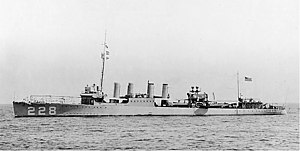USS John D. Ford (DD-228)
 |
|
| History | |
|---|---|
|
|
|
| Namesake: | John Donaldson Ford |
| Builder: | William Cramp & Sons |
| Laid down: | 11 November 1919 |
| Launched: | 2 September 1920 |
| Commissioned: | 30 December 1920 |
| Decommissioned: | 2 November 1945 |
| Struck: | 16 November 1945 |
| Honours and awards: |
John D Ford received a Presidential Unit Citation (specifically honoring her "extraordinary heroism in action during the Java Campaign, 23 January - 2 March 1942) and four battle stars for her World War II service |
| Fate: | sold for scrap 5 October 1947 |
| General characteristics | |
| Class and type: | Clemson-class destroyer |
| Displacement: | 1,190 tons |
| Length: | 314 feet 5 inches (95.83 m) |
| Beam: | 31 feet 9 inches (9.68 m) |
| Draft: | 9 feet 3 inches (2.82 m) |
| Propulsion: |
|
| Speed: | 35 knots (65 km/h) |
| Complement: | 101 officers and enlisted |
| Armament: | 4 x 4 in (100 mm) guns, 1 x 3 in (76 mm) AA, 2 x .30 (7.62 mm) cal MG., 12 x 21" (533 mm) torpedo tubes. |
USS John D. Ford (DD-228/AG-119) was a Clemson-class destroyer in the United States Navy during World War II. She was named for Rear Admiral John Donaldson Ford.
John D. Ford was laid down 11 November 1919 and launched 2 September 1920 from William Cramp & Sons; sponsored by Miss F. Faith Ford, daughter of Rear Admiral Ford; and commissioned as Ford 30 December 1920, Lieutenant, junior grade L. T. Forbes in temporary command.
After acceptance trials off New England, John D. Ford received Lieutenant Commander C. A. Pownall as commanding officer 16 July 1921. On 17 November, while operating along the eastern seaboard, her name was changed to John D. Ford. After training in the Caribbean, she departed Newport, Rhode Island, 20 June 1922 for permanent duty with the Asiatic Fleet. Sailing via the Mediterranean Sea, the Suez Canal, and the Indian Ocean, she arrived Cavite, Manila Bay, 21 August to begin almost two decades of service in the Far East.
Prior to the outbreak of World War II, Ford operated out of Manila, cruising Asiatic waters from southern China to northern Japan. During April and May 1924, she helped establish temporary air bases on the Japanese Kurile and Hokkaidō Islands in support of the pioneer, global flight between 9 April and 28 September by the U.S. Air Service.
...
Wikipedia
